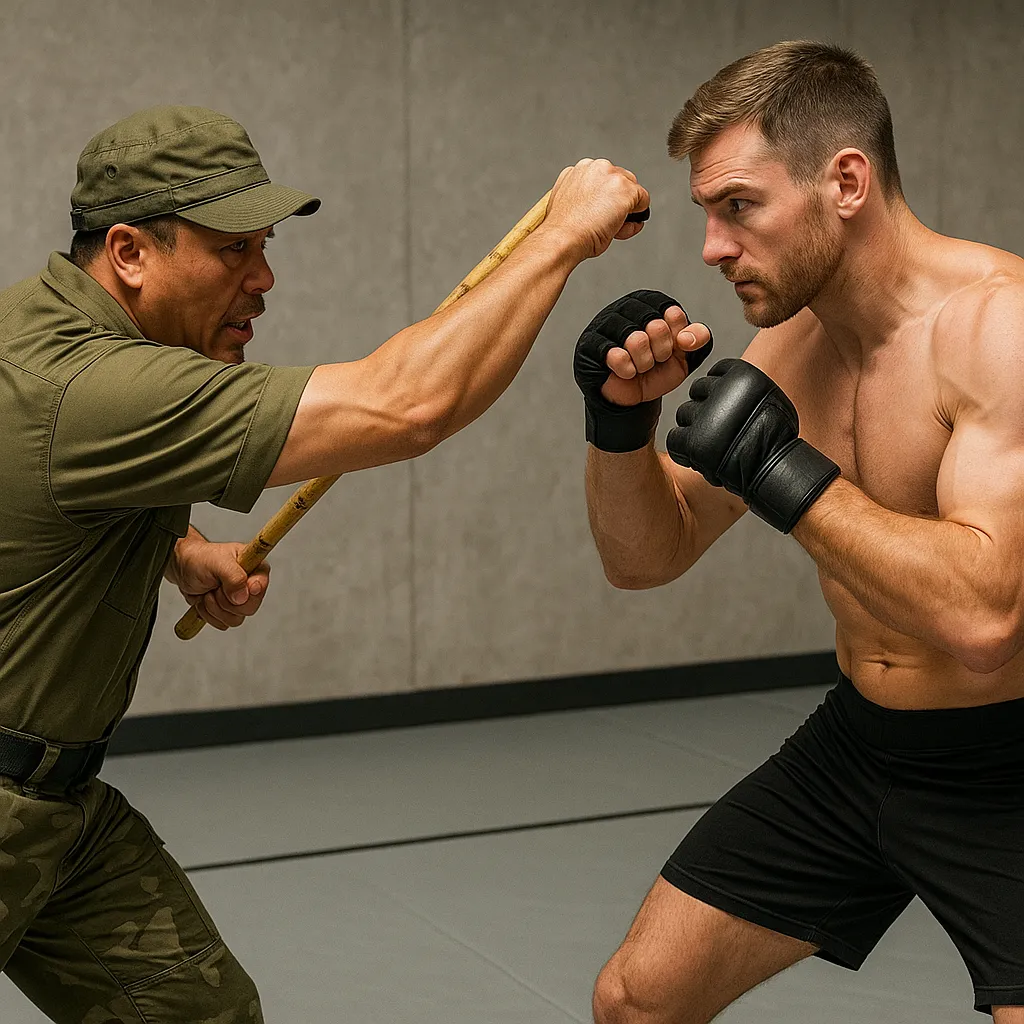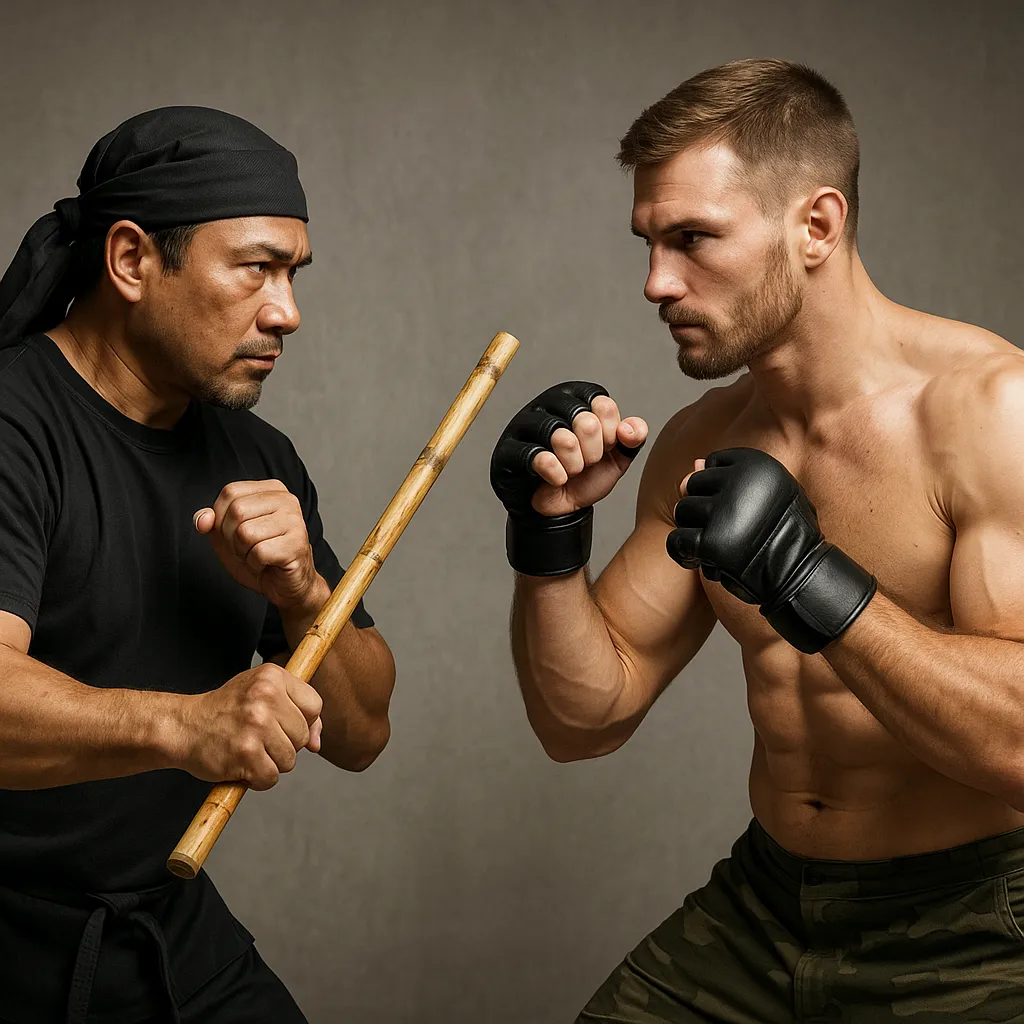The Essence of Eskrima: Weapon First, Mind Always Present
Foundational Assumptions and Training Origins
Eskrima (also known as Arnis or Kali, depending on regional lineage) is a Filipino martial art rooted in centuries of tribal warfare, colonial resistance, and practical street defense. Unlike most empty-hand systems, Eskrima begins with weapons—primarily sticks, knives, and improvised tools—as its core curriculum. The central assumption of Eskrima is that weapons are part of real combat and must be understood first; empty-hand techniques are built from the same movement patterns.
Combat Style and Tactical Philosophy
Eskrima is direct, flow-oriented, and tactical. It emphasizes angular attacks, economy of motion, targeting vital points, and adaptability. The core drills like sinawali (weaving patterns) or hubud-lubud (reactive flow) are more than motor exercises—they cultivate fluidity under pressure and reflex-based counters. Defense is often done through deflections, body angling, and distance management, not static blocks.
Strategically, Eskrimadors are trained to read timing and structure, often prioritizing interception over reaction. This is vital when facing an armed opponent—hesitation can be fatal. Sparring, when included, is typically done at high speed with padded weapons or limited-contact real weapons, simulating the chaotic nature of street encounters.
Training Style and Mental Framework
A distinctive trait of Eskrima is interdisciplinary exposure. Practitioners rotate between single stick, double stick, knife, and empty-hand training in one session. This cultivates situational awareness and body-mind adaptability. Rather than mastering static forms, the training is structured around flow drills, reaction sequences, and real-time adaptation.
Mentally, Eskrima fosters sharp reflexes, acute situational awareness, and calmness under sudden threat. Philosophically, it emphasizes efficiency, realism, and respect for danger. Many systems include meditation or reflection through breathing and ritualized practice, especially in tribal or family-preserved lineages.
Everyday Utility and Transfer to Real Life
The practical value of Eskrima is high for self-defense: its emphasis on weapon familiarity, short-range engagement, and non-linear movement makes it highly applicable in close-quarters situations—e.g., mugging, home invasions, or parking-lot altercations. Moreover, the training promotes fast decision-making and dexterity, which often transfers well to emergency scenarios, law enforcement, and even professions like nursing or security work.
Benefits for Individual Practitioners
Students of Eskrima often gain rapid improvement in hand-eye coordination, reaction speed, and threat perception. Unlike some traditional arts requiring years before self-defense competence, Eskrima gives practical tools early on. It’s particularly suitable for adults or older practitioners due to its technical depth and the ability to scale intensity.
Physically, it enhances wrist and shoulder mobility, core stability, and balance. Psychologically, it trains quick decision-making under stress—an often neglected element in traditional kata-based systems.
Prerequisites for Training
No previous martial arts experience is needed. Since the art scales well across age groups and physical abilities, it is beginner-friendly. However, a willingness to handle weapons and engage in fast-paced drills is essential. Students benefit most when they have basic coordination and open-mindedness to unconventional movement logic.
The Nature of MMA: Adaptive Combat through Pressure and Range Mastery
Foundational Assumptions and Development Origins
Mixed Martial Arts (MMA) is not a style but a modern combat sport and methodology combining multiple disciplines—wrestling, boxing, Muay Thai, Brazilian Jiu-Jitsu, and more—into an integrated system. Its roots trace back to vale tudo matches in Brazil and the birth of the UFC in 1993, where styles collided and a new hybridized combat method emerged.
MMA assumes unarmed, rule-governed combat between two conditioned athletes in a controlled environment, usually a cage or ring. The implicit assumption is that the fighter must be proficient in all ranges: striking, clinch, takedowns, and ground.
Combat Style and Strategic Mindset
MMA is fundamentally pressure-based and range-adaptive. Fighters constantly shift between ranges, from jabs and leg kicks to clinch wrestling and submissions. Techniques are chosen based on positional dominance, opponent’s reaction, and energy management.
There is no rigid form system—rather, skill modules from various arts are integrated through pad work, live drilling, and sparring. Fighters train to maintain output under fatigue, react to real resistance, and execute under stress.
Strategically, MMA is grounded in data-driven feedback: video analysis, opponent scouting, and injury prevention are crucial. Fighters are not just martial artists but athletes—nutrition, recovery, and sports psychology are all embedded in the training culture.
Training Style and Psychological Resilience
MMA training is structured and periodized. Typical sessions involve multiple hours per day across disciplines: striking in the morning, grappling mid-day, conditioning or sparring in the evening. Live sparring, pressure testing, and cardio stress are central. Many gyms run simulated fight camps to replicate the physical and mental demands of competition.
Mentally, MMA cultivates grit, resilience, and composure under fire. A key feature is the exposure to real pain and defeat, which builds both humility and strategic thinking. Fighters must constantly adapt—if the jab fails, they shoot; if the takedown is stuffed, they clinch or pull guard. This fluid adaptability is both cognitive and kinesthetic.
Practical Utility in Everyday Life
Although MMA is often framed as sport, it offers substantial self-defense value: awareness of distance, timing, and explosive entry; understanding leverage and control in grappling; and the ability to remain calm under pressure. However, due to its ring-based limitations, it lacks direct training in weapons defense or multiple attackers, which limits its scope in certain self-defense scenarios.
Still, the fitness benefits, mental toughness, and awareness of body mechanics make it a powerful personal development tool, especially for those seeking measurable growth and competition.
Benefits for Individual Practitioners
MMA improves cardiovascular fitness, muscular endurance, agility, and explosiveness. Practitioners learn to think under fire, adapt to unexpected changes, and overcome fear. For those seeking physical transformation or a high-stakes challenge, MMA is among the most demanding and rewarding paths.
Students often develop strong team bonds due to intense training environments and shared goals. Unlike traditional styles, progress in MMA is meritocratic—either the move works under pressure, or it doesn’t. This clarity can be motivating for goal-driven learners.
Prerequisites for Training
A solid physical foundation is helpful—basic mobility, cardiovascular health, and no severe joint injuries. However, many modern gyms offer beginner MMA programs. Mental resilience is a bigger factor: the training intensity is high, and injuries or plateaus are common. Those looking for a less combative path may struggle with the grind.
Eskrima vs. MMA in Controlled Environments
Gym and Sparring Contexts
In structured training environments, both Eskrima and MMA offer intensity, skill progression, and measurable improvement—but in radically different formats.
- Eskrima Sparring: Often performed with padded sticks or wooden weapons (e.g., rattan sticks), Eskrima sparring emphasizes reflex-based engagement, angular footwork, and precise targeting. Matches may simulate knife disarms, close-quarters stick combat, or empty-hand vs. weapon scenarios. The emphasis is on timing, flow, and control, rather than brute force. Sparring rules vary significantly between schools, from point-based stick duels to flowing continuous exchange.
- MMA Sparring: Heavily regulated and contact-intensive, MMA sparring typically follows round-based structure (3×5 min, etc.) and includes takedowns, striking, and ground control. Protective gear (mouthguards, gloves, shin guards) is standard. Training focuses on managing fatigue, adjusting tactics in real-time, and achieving positional or striking dominance. There’s an ever-present risk of injury, making sparring both a test and a filter—those lacking mental resilience may struggle.
Key Difference: Eskrima sparring rarely includes ground fighting or clinch-heavy work unless integrated from another system. It is more cognitive and reaction-based, ideal for cultivating quick reflexes and decision-making under uncertainty. MMA sparring, by contrast, is exhaustive, full-range, and conditions the athlete to perform under pressure and pain.

Practical Comparison in Real-Life Scenarios
Self-Defense and Everyday Encounters
Real-life situations are chaotic, unpredictable, and often involve uneven circumstances—surprise, fear, uneven numbers, or weapons. Here, the foundational assumptions of each style reveal their strengths and limits.
| Scenario | Eskrima Strength | MMA Strength |
|---|---|---|
| Armed attacker (knife, stick) | Immediate weapon awareness and disarming flow drills; emphasis on controlling the weapon hand and disabling quickly | Limited response unless trained in weapons defense modules; might close distance to clinch, but exposed to slashes |
| Crowded or tight space (elevator, hallway) | Short-range strikes with sticks or improvised tools; trapping and redirection techniques | Elbow and knee work; dirty boxing and wall control can be effective |
| Multiple attackers | Emphasis on evasion, redirecting force, and mobility; angle-based footwork | Difficulty increases due to takedown vulnerability; clinch or ground game becomes a liability |
| Unarmed drunk aggressor | De-escalation and non-lethal targeting (wrists, forearms); weapon can be used as deterrent | Clinch, takedown, and positional control; safer containment |
| Surprise encounter (doorway, car) | Weapon deployment and quick reaction time; ability to defend while seated | Struggles with seated start or tight weapon defense unless cross-trained |
Concrete Technique Comparison
- Inside Deflection + Counter (Eskrima)
- A stick comes toward the head: the defender parries it inward, redirects with a circular motion, and delivers a quick strike to the hand or temple.
- Biomechanics: minimal wind-up, efficient transfer of energy through joint rotation.
- Contrast in MMA: Such precise deflections are rare; defense is more likely a cover or dodge, followed by a takedown or jab counter.
- Clinch Entry + Double Leg Takedown (MMA)
- Opponent strikes; fighter slips or blocks, clinches, and shoots a double leg to bring the opponent down.
- Biomechanics: body level changes, hip drive, explosive torque.
- Contrast in Eskrima: Takedowns may be executed via foot sweeps or joint locks but less common and often weapon-assisted.
- Knife Strip (Eskrima)
- Opponent slashes; defender parries, controls the wrist, rotates the blade out with a leverage point (e.g., thumb pressure), and counters.
- Contrast in MMA: Knife defense is not systematically taught—most gyms acknowledge it’s outside MMA’s scope.
Age Suitability and Long-Term Engagement
Both Eskrima and MMA are adaptable, but their suitability varies significantly with age, physical condition, and training goals.
Children (Under 13)
- Eskrima: Excellent introduction to coordination, rhythm, and awareness. Light weapon training (foam or sticks) develops motor skills and focus. The lack of ground grappling makes it safer and less intense for younger kids.
- MMA: Many gyms offer youth MMA, with striking and grappling taught in controlled form. Still, the full-contact element is inappropriate for younger children unless adapted (e.g., BJJ focus, light contact).
Teens and Young Adults (13–30)
- Eskrima: Offers deep technical learning and personal growth; often chosen as a complementary system.
- MMA: Prime demographic. Body is resilient, and the learning curve is steep but manageable. Ideal for competitive goals or physical development.
Adults (30–50)
- Eskrima: Highly suitable, especially for those seeking practical self-defense, cultural immersion, or low-impact training. Allows progression without hard sparring.
- MMA: Still viable, especially for fitness and personal challenge. However, recovery time increases, and injury risk is more significant. Modified training regimens or hybrid classes (MMA fundamentals) are recommended.
Older Adults (50+)
- Eskrima: Remains accessible due to adaptability and emphasis on flow and precision over force. Many masters teach well into their senior years.
- MMA: Rare for new practitioners unless extremely fit or with prior experience. Risks in striking and takedown drills often outweigh benefits. Better suited to focus-specific classes (e.g., boxing cardio, BJJ technique).
Summary of Core Contrasts
| Factor | Eskrima | MMA |
|---|---|---|
| Combat Range | Primarily mid-to-close with weapons | All ranges: striking, clinch, ground |
| Focus | Weapons, flow, disarm, improvisation | Conditioning, pressure-tested versatility |
| Training Impact | Joint mobility, reflexes, weapon familiarity | Explosiveness, endurance, pain tolerance |
| Cognitive Demand | High: spatial awareness, timing, improvisation | High: strategy, reaction, adaptability |
| Ideal Entry Age | Any age, especially adults | Teens/young adults for full experience |


